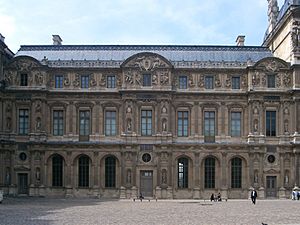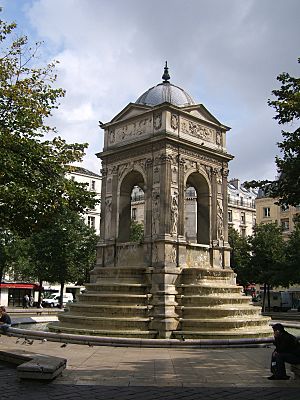Pierre Lescot facts for kids

Pierre Lescot (c. 1515 – 10 September 1578) was a famous French architect during the French Renaissance. He is best known for his work on the Louvre palace in Paris. He also designed the Fontaine des Innocents. Pierre Lescot helped bring ideas from classical Roman and Greek architecture into French buildings.
About Pierre Lescot
Pierre Lescot was born in Paris. King Francis I hired him to work on the Palais du Louvre. The king wanted to change the old medieval castle into a grand palace. Lescot's plan was chosen over one by an Italian architect. His design included three sides of a large square courtyard with beautiful apartments. The fourth side, facing the city, was likely meant to be an open arcade.
After King Francis I died, Henry II kept Lescot as the main architect. Lescot worked on the Louvre until he died. However, only the west side and part of the south side were finished. This part is now called the Aile Lescot, or "Lescot Wing."
This wing, built from 1546 to 1551, set a new style for French architecture. It has two main floors and an attic. The attic is decorated with detailed carvings by Jean Goujon. The building has a sloping roof, which was common in France and good for rainy weather. The windows on the ground floor are deeply set, making them look like an arcade. The central and end sections stick out slightly and have small round windows.
On the second floor, thin, fluted pillars separate the windows. These windows have alternating triangular and arched tops. Jean Goujon's sculptures and decorations fit perfectly with Lescot's design. The ground floor has a room called the Salle des Caryatides. It is named after Goujon's four caryatid figures, which are statues of women that support the musicians' balcony. Other parts of Lescot's work at the Louvre include the Salle des Gardes and the Henri II staircase.
Some of Lescot's earlier projects (1540–1545) included a screen in Saint-Germain l'Auxerrois church. Only some sculptures by Goujon from this project still exist. In Paris, he also designed the Hôtel de Ligneris (1548–1550), which is now the Musée Carnavalet. This building was later changed a lot by another architect.
Lescot's most famous work outside the Louvre is the Fountain of Nymphs (1547–1549). Here, Jean Goujon's sculptures are very important to the fountain's beauty. Lescot also worked on the Château de Vallery.
We don't know much about Lescot's early life or if he ever visited Italy. He might have learned about Italian architecture from books and drawings from the School of Fontainebleau. All of Lescot's known buildings feature sculptures by Jean Goujon, who worked closely with him at the Louvre.
Unlike many architects of his time, Pierre Lescot did not come from a family of builders. His father, also named Pierre Lescot, was a wealthy lord. Pierre Lescot inherited his father's lands. A poet named Ronsard wrote that Lescot enjoyed drawing and painting when he was young. After he turned 20, he studied mathematics and architecture. However, his wealth and official duties might have limited his artistic work later on.
After Pierre Lescot died, Jean Baptiste Androuet du Cerceau took over his role at the Louvre.
See also
 In Spanish: Pierre Lescot para niños
In Spanish: Pierre Lescot para niños
- Architecture of Paris
- Cour Carrée
- French Renaissance architecture
Other important architects of the French Renaissance:
- Philibert Delorme
- Jean Bullant
- Androuet du Cerceau, a family of designers and architects
- Jean Goujon



